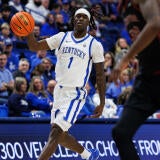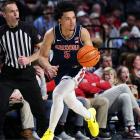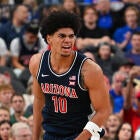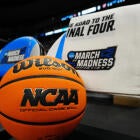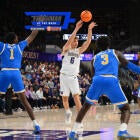2023 NCAA Tournament: Where to pick upsets in this year's bracket based on previous trends
There have been multiple 12-over-5 upsets in six of the last 10 NCAA Tournaments
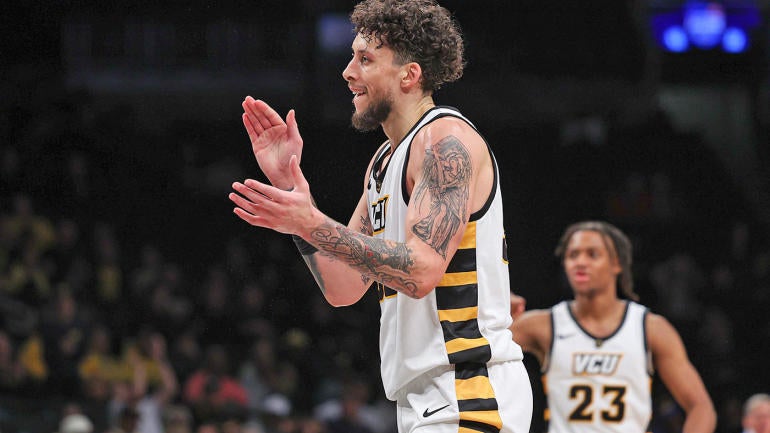
There are few better feelings than nailing an upset in your NCAA Tournament bracket. Whether it's because of meticulous research or just plain luck, hitting on a lower seed often gives you a significant edge in your bracket pool -- not only in the first round but beyond, where your fellow competitors may have had a top team advancing even further.
It's important to know, then, how often you should expect these sorts of upsets. Even having a general idea of how many double-digit seeds you should pick is helpful to keep in mind while making your choices. This will be the 38th year since the NCAA Tournament expanded to 64 teams in 1985 (it expanded again -- to 68 -- in 2011). Since that 1985 expansion, here is the record of seed underdogs in the first round:
| Seed vs. seed | Win-Loss | Win pct. |
|---|---|---|
No. 9 vs. No. 8 | 76-72 | .514 |
No. 10 vs. No. 7 | 58-89 | .395 |
No. 11 vs. No. 6 | 57-91 | .385 |
No. 12 vs. No. 5 | 53-95 | .358 |
No. 13 vs. No. 4 | 31-117 | .209 |
No. 14 vs. No. 3 | 22-126 | .149 |
No. 15 vs. No. 2 | 10-138 | .068 |
No. 16 vs. No. 1 | 1-147 | .007 |
We can take away a few things here:
- The 8-9 game is nearly a 50-50 split. Don't fret too much about picking too many "upsets" here. In general, these teams are about as even as they come. As you can see, there's a falloff between 9-over-8 winning percentage and 10-over-7 winning percentage.
- The likelihood of a seeding upset falls off dramatically after the infamous 12-5 matchup. There has been at least one 12-over-5 upset in 33 of the 37 NCAA Tournaments since the 1985 expansion, and there have been multiple such upsets in six of the last 10, including two last year.
- That doesn't mean you should be afraid to take a 13-, 14- or 15-seed. These upsets do happen, and they've been especially prominent recently. Over the last six tournaments, 12 teams seeded 13 or lower have won in the first round. That's two per year. Compare that to the previous six tournaments (2010-15), when just two teams seeded 13 or lower won in the first round. Cinderella is back!
The trickiest part, of course, is identifying which low seed you should take. Here's one team from each lower-seed line -- 9 through 16 -- that has the best chance of getting at least two songs at the Big Dance.
(9) Florida Atlantic Owls
First-round opponent: Memphis Tigers
Florida Atlantic is one of the deepest teams in March Madness and comes in playing some of its best basketball. The Owls go nine players deep and romped through the Conference USA Tournament, winning the title game with a 22-point thumping of UAB. This is a really, really good team. No one, regardless of schedule or conference, wins 31 games by accident.
The Owls had C-USA's top offense and No. 2 defense, according to Kenpom's numbers. They shoot the ball well, rebound extremely well -- especially on the defensive end -- force a lot of turnovers and don't commit too many themselves. It's those final two attributes that will be key against Memphis. The Tigers love to get out and run; their 19.6 transition points per game rank fourth in Division I. Florida Atlantic allows just 8.0 transition points per game -- tied for 20th in Division I -- and rank in the 93rd percentile defending in transition on a per-possession basis.
(10) Boise State Broncos
First-round opponent: Northwestern Wildcats
Both Boise State (lost three of last five) and Northwestern (lost four of last five) enter the NCAA Tournament in mini slumps. But Boise State has a great chance here to pull the (slight) upset thanks to its length, and its strengths matchup up well with Northwestern's strengths. The Broncos feature six regulars that stand 6-foot-5 or taller, and that size -- especially on the wings -- could overwhelm a Northwestern team that leans on three-guard lineups. Northwestern's biggest strength is forcing turnovers, but Boise State does a good job handling the ball, in large part thanks to standout point guard Marcus Shaver Jr. Boise State boasts a strong defense of its own, and in a game where margins will be thin and points will be at a premium, the Broncos could have more reliable scorers down the stretch.
(11) Providence Friars
First-round opponent: Kentucky Wildcats
The top storyline of this game is Bryce Hopkins. After barely playing last season at Kentucky, Hopkins transferred to Providence and blossomed into a First Team All-Big East performer. Hopkins stands a rugged 6-foot-7 and 220 pounds, gets to the free throw line at will and has expanded his face-up game. He will be a handful for Oscar Tshiebwe on both ends of the court. Tshiebwe, of course, represents Kentucky's greatest strength: Offensive rebounding. The Wildcats' 7.9 points off putbacks alone rank seventh in Division I this season, but Providence has the personnel to at least limit that impact. Coach Ed Cooley also has a bevy of veteran guards willing and able to take on big roles when needed. Kentucky has looked like a title contender one day and a bubble team the next; Providence will be ready for whichever version comes its way.
(12) VCU Rams
First-round opponent: Saint Mary's Gaels
Two years ago, we were robbed of watching one of the most entertaining guards in the nation -- Nah'Shon "Bones" Hyland -- when COVID-19 forced VCU out of the tournament. Now, the Rams are back with a new point guard (also with a great nickname) for America to fall in love with: Adrian "Ace" Baldwin Jr., the Atlantic 10 Player of the Year and Defensive Player of the Year.
VCU has won nine straight games and is terrific defensively. Offensively, the Rams are just decent shooting the ball but do a great job getting to the free throw line. Saint Mary's is far from a pushover -- the Gaels won the West Coast Conference regular-season title, after all -- but if Baldwin gets going, he'll be the best player on the floor. That's a huge ingredient for success when searching for the 12-5 upset.
(13) Kent State Golden Flashes
First-round opponent: Indiana Hoosiers
Colleague David Cobb broke down why Kent State could be a great Cinderella candidate, and I'm absolutely on board. The journey to becoming Cinderella, though, starts with the opening game. Indiana is good but not unbeatable.
The Golden Flashes are awesome defensively and have a standout guard in Sincere Carry who -- for lack of a better term -- can carry the load offensively. He had 35 points in a win over Akron in the regular-season finale and 26 more in the MAC Tournament title win over Toledo. The Golden Flashes are undersized and will struggle with Indiana's Trayce Jackson-Davis on the inside, as almost every team does. But if Carry can win his matchup with freshman Jalen Hood-Schifino at the point guard spot, Kent State will have a chance to send the Hoosiers packing.
(14) Montana State Bobcats
First-round opponent: Kansas State Wildcats
At this point, we're looking for something -- anything -- that could spark an upset, and Montana State might have that "something" against Kansas State. The Bobcats get to the line at the second-highest rate of any NCAA Tournament team, and the Wildcats allow a ton of free throw attempts. Furthermore, while Kansas State has one of the nation's top offensive duos in Markquis Nowell and Keyontae Johnson, the Wildcats turn the ball over a lot, a habit that can come back to bite teams in the postseason. If Montana State can get one of Nowell or Johnson in early foul trouble, that's a plus.
(15) Colgate Raiders
First-round opponent: Texas Longhorns
Coach Matt Langel knows how to put a scare into a highly ranked team. The Raiders had a late lead before eventually falling to Wisconsin last year, jumped out to a big lead before running out of steam against Arkansas in 2021 and nearly took down Tennessee in 2019. It would seem unlikely that they'd finally break through against a Texas team fresh off a Big 12 Tournament title, but stranger things have happened. The Raiders shoot the 3-pointer at the highest percentage in Division I. Plus, they are terrific inside the arc and rarely turn the ball over. Tucker Richardson -- the rare Colgate wing who isn't a great outside shooter -- had a triple-double in the Patriot League Tournament championship game and had double-doubles in the semifinal and quarterfinal.
(16) Northern Kentucky Norse
First-round opponent: Houston Cougars
One can always hope, right? Northern Kentucky plays at one of the nation's slowest paces, forces a high percentage of turnovers and shoots decently from three. Guard Marques Warrick is a solid player who had 45 points in a game against Tennessee Tech earlier this season.
In terms of chances to beat Houston, that's where the positives just about end. The idea here is Houston struggles enough from the field, and maybe Marcus Sasser (groin) isn't quite 100%, and maybe Northern Kentucky can make enough 3-pointers and force enough turnovers and maybe, somehow, not get completely destroyed on the boards, and... you get the point. We're probably not looking at UMBC 2.0.





